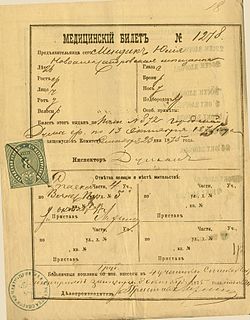

Yellow ticket, yellow passport or yellow card[1] (Russian: жёлтый билет[2]) was an informal name of a personal identification document of a prostitute in the Russian Empire between 1843 and 1909. The document combined an ID card, a residence permit, a license to practice prostitution, and prostitute's medical check-up card. The official title of the document varied: medical card (медицинский билет), replacement card (заменительный билет), etc. The title "replacement card" refers to the fact that upon registration, the prostitute left her original passport or residence permit (вид на жительство) in the local police office and was issued the "yellow card" as a replacement personal ID. The carriers of the card were subject to periodic medical check-ups. This requirement was dropped in 1909.[1]
Zhyolty bilet ("yellow card") and zheltobiletnitsa ("yellow-card-holder") have become euphemisms for prostitution and prostitutes in Russian language.
A traditional etymology is that the document was named so for its yellow color. Another alleged association of yellow color with prostitution is that Tsar Paul (“Pavel”) I, known for his obsession with uniforms, ordered that prostitutes wear yellow dresses to differentiate them from other women in public settings.[1]